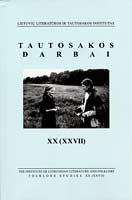Darna instrumentiniame muzikavime ir jos suvokimas
Tuning in the instrumental music and its perception
Author(s): Rūta ŽarskienėSubject(s): Customs / Folklore
Published by: Lietuvių literatūros ir tautosakos institutas
Keywords: Folk musical instruments; skudučiai; multi-pipe whistles; tuning of folk musical instruments; Northeastern Europe
Summary/Abstract: The author of the article investigates ways of tuning and sound-sets of Lithuanian multi-pipe whistles (skudučiai), as well as comparing them to principles of tuning instruments of similar type, used by other peoples (Russians, Komis). According to the presented data we may assume that Lithuanians as well as Russians and Komis selected their tubes “by eye” and tuned them “by ear”. Obviously, the performers were little concerned about the correct tuning of multi-pipe whistles. Visual proportions of pipes, i.e., equal distance between the pipes and their general appearance (straightness, smoothness) seemed much more important to them than the audible moment. Players had neither any standard measurements nor specific requirements for the pitch and intervals between the pipes. For them, the very order of distribution was much more important than the right pitch, i.e. pipe with the lowest pitch was followed by the one with a higher pitch and then by the one with still higher, etc. Country musicians grasped the sound correlations of the instrument (i.e. sound scales) more generally – as the collation of particular pitch zones. Thus, we may conclude that different sound scales usually occur as the result of the way of conceiving the instrument.
Journal: Tautosakos darbai
- Issue Year: 2004
- Issue No: 27
- Page Range: 96-101
- Page Count: 6
- Language: Lithuanian

